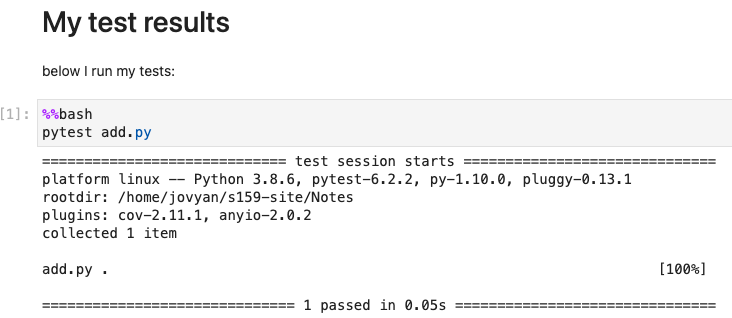Homework 3: Coding style, docstrings, algorithmic choices, and unit tests
Contents
3. Homework 3: Coding style, docstrings, algorithmic choices, and unit tests¶
Statistics 159/259, Spring 2021
Due 2/14/2021, 11:59PM PT
Profs. Perez and Stark, Department of Statistics, UC Berkeley.
This assignment is worth a maximum of 30 points.
3.1. [20 Points] Implement a function three ways and test it.¶
This question asks you to write three different Python functions to calculate the chi-square statistic for the “two-sample problem” for categorical data, and write a unit test for those functions.
The functions and tests should be documented well and readable.
The code should have appropriate, useful docstrings and follow PEP-8 and PEP-257. You should run
pycodestyleandpep257on your functions and resolve any errors/warnings.The docstring should explain the approach used in each function, so the reader can understand how they differ.
The tests should “exercise” every executable line of your code
The input is two lists, \(x = (x_1, \ldots, x_n)\) and \(y = (y_1, \ldots, y_m)\). Consider the multiset \(z = \{z_1, \ldots, z_N\}\) containing the \(N = n+m\) (not necessarily distinct) elements of \(x\) and \(y\). Let \(\{u_k\}_{k=1}^K\) (\(K \le N\)) denote the unique values in \(z\) and let \(\pi_k\) denote the relative frequency of the value \(u_k\) among the elements of \(z\); that is,
Hint: if you’re not familiar with multisets, use the search function in the class site and you will find background material on the concept.
Let \(E_k \equiv n \pi_k\) and let \(O_k \equiv \#\{ j \in \{1, \ldots, n\} : x_j = u_k \}\); that is, \(O_k\) is the number of elements of \(x\) that are equal to \(u_k\). (The symbol \(E\) is mnemonic for “expected” and \(O\) stands for “observed.”)
The chi-square statistic for these data for the two-sample problem is
For example, suppose the lists are \(x = (0, 0, 1)\) and \(y=(0, 1, 1)\), so \(n=m=3\). The pooled multiset is \(z = \{0, 0, 0, 1, 1, 1\}\). The \(K=2\) unique values in the multiset are \(u = \{0, 1\}\). Their relative frequencies are \(\pi_0 = \pi_1 = 3/6 = 1/2\). The “expected” numbers of the unique values among the \(n\) elements of \(x\) are \(E_0 = n\pi_0 = 3\times 1/2 = 3/2\) and \(E_1 = n\pi_1 = 3\times 1/2 = 3/2\). The observed numbers are \(O_0 = 2\) and \(O_1 = 1\). The chi-square statistic for these data is
[12 points] Write three different Python functions that (each) take as input \(x\) and \(y\) and return \(\chi^2\). The functions should use different strategies and/or different data structures to calculate \(\chi^2\). They should all have the same input signature and type of return value. Call them
chisq_1,chisq_2andchisq_3. This is a brief outline of what the function skeleton should look like for each of these:
def chisq_1(x, y):
"""
one-line description.
Further details...
Rest of your docstring
"""
# Your code goes here...
return your_answer
[3 points] Compare the speed of your three functions on a variety of inputs of different lengths. Comment on the tradeoff between speed and readability among your three implementations. Hint: use IPython’s
%timeitline magic to get accurate timings of single function calls; type%timeit?to find out more information about%timeit.[4 points] Write a unit test for the functions to ensure that they work correctly for arbitrary input lists \(x\) and \(y\).
Your deliverables for this problem will consist of:
A Python file, called
chisq.py, containing the three function implementations plus the necessary tests. Note that your tests need to call all three functions separately, so that they can be validated independently.A Jupyter notebook, called
chisq_testing.ipynb, where you show the output ofpytest,pycodestyleandpep257. You can use either cells with individual commands typed as!command, or cells that use the%%bashcell magic to execute the entire cell as a command-line operation. This is an illustration of what that can look like with a hypotheticaladd.pyfile and only showing the call forpytest:

The notebook is also where you will run your timings, include the results and discuss them.
3.2. [10 Points] Unit test for the acceptance function for a randomized hypergeometric test¶
Write a unit test for the function fisher_accept in the tests notebook (in GitHub: https://github.com/UCB-stat-159-s21/site/blob/main/Notes/tests.ipynb). Your test should check for proper behavior as all input parameters are varied.
Make a pure python file called
fisher.pythat contains, copied from thetests.ipynbNotebook, the implementation offisher_accept()plus any necessary imports. In that file, add your test functions below the implementation offisher_accept. Your code should follow PEP-8 and PEP-257.As in the problem before, your deliverables will be both the
fisher.pyfile, along with a notebook calledfisher_testing.ipynb. The notebook will include your runs of the tests. Your test functions (infisher.py) should each have a docstring that explains what condition is being tested.If your tests fail and you are convinced that there is an error in the original function, please provide a discussion as well as a second version called
fisher_accept2()that corrects the problem and passes your tests. Show both the failed and successful tests.
